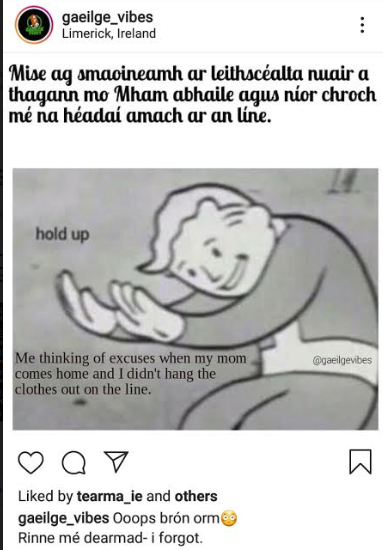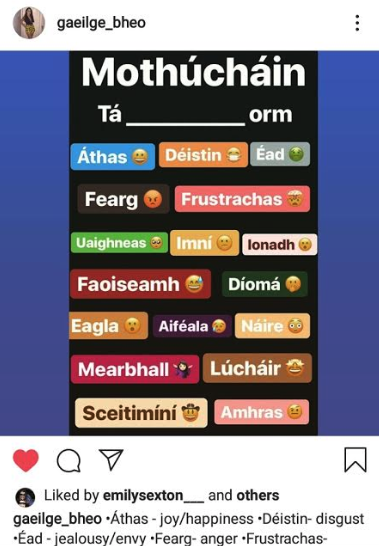Alongside the swaths of selfies and aspirational captions on Instagram, Irish teachers are working to preserve their traditional language in a modern context.For centuries, the Irish language has been forced to endure anglicization’s belligerent attempts to usurp it. In contemporary Ireland, a worrying amount of youths consider the traditional tongue to be pointless, paltry, and dead.This perception was bolstered in April when the Data Protection Commission (DPC), the agency tasked with enforcing EU data protection laws in Ireland, said that supervisory authorities had advised that Irish people have no "absolute" right to have their entries in official databases corrected to include fadas. A síneadh fada, or simply “fada,” is similar to an accent in other languages (for example, “í” instead of “i"), and constitutes an important part of Irish names and language.Spurred to action by the DPC's comment, Irish teachers from all over the country have taken to Instagram to entertain and educate young people with the goal of revitalizing the language. Siobhán Fitzpatrick, an Irish teacher who runs the Gaeilge Vibes instagram account, said that her followers appreciate how she posts about an “accessible, lighter side of Irish through puns and memes.”But this breezy content is packed full of passion and defiance. “Not only are fadas integral to the Irish language in regards to pronunciation, they completely change the meaning of words,” Irish secondary school teacher Eimhir Nic Giolla Phádraig tells me. Nic Giolla Phádraig is also the person behind the Gaeilge Bheo (which means 'Irish alive') Instagram account. “Without fadas, Ronán (pronounced roe-nawn), would be Ronan (roe-nin)," she said.Fitzpatrick built on how the inclusion or removal of fadas can drastically change the meaning of words. “Ait means 'strange' in Irish, [and] áit means 'place.' Seán is a name, sean means 'old,'" she said.In Nic Giolla Phádraig’s case, the decision to create an Instagram account devoted to Irish was directly influenced by the DPC’s April statement. After posting a video on her personal page in which she broke down the problematic implications of denouncing fadas, her inbox was flooded with messages commenting on how nice it was to hear Irish being spoken, she said.According to the teachers behind these accounts, the primary reason young people so readily dismiss such a vital part of their heritage has more to do with a failed school curriculum that’s in desperate need of reform than a statement from the DPC.“Students are coming into secondary school with very little Irish and are expected to be able to discuss the inner workings of poems or short stories,” Fitzpatrick says. “That’s hard for some to do in English!”This begets what Fitzpatrick refers to as “the everyday battle,” in which students claim to hate Irish. She's heard students say that they’ll never use it, it won’t help them get a job, and the material is boring, she said. Some students even attempt to get official exemptions from the subject.“It’s book Irish,” Nic Giolla Phádraig said. “People don’t realize that if we want to portray Irish as a living language, we have to talk about sex in Irish, about modern issues and everyday occurrences as Gaeilge [in Irish]. Irish is not a subject, it’s a language.”
“Not only are fadas integral to the Irish language in regards to pronunciation, they completely change the meaning of words,” Irish secondary school teacher Eimhir Nic Giolla Phádraig tells me. Nic Giolla Phádraig is also the person behind the Gaeilge Bheo (which means 'Irish alive') Instagram account. “Without fadas, Ronán (pronounced roe-nawn), would be Ronan (roe-nin)," she said.Fitzpatrick built on how the inclusion or removal of fadas can drastically change the meaning of words. “Ait means 'strange' in Irish, [and] áit means 'place.' Seán is a name, sean means 'old,'" she said.In Nic Giolla Phádraig’s case, the decision to create an Instagram account devoted to Irish was directly influenced by the DPC’s April statement. After posting a video on her personal page in which she broke down the problematic implications of denouncing fadas, her inbox was flooded with messages commenting on how nice it was to hear Irish being spoken, she said.According to the teachers behind these accounts, the primary reason young people so readily dismiss such a vital part of their heritage has more to do with a failed school curriculum that’s in desperate need of reform than a statement from the DPC.“Students are coming into secondary school with very little Irish and are expected to be able to discuss the inner workings of poems or short stories,” Fitzpatrick says. “That’s hard for some to do in English!”This begets what Fitzpatrick refers to as “the everyday battle,” in which students claim to hate Irish. She's heard students say that they’ll never use it, it won’t help them get a job, and the material is boring, she said. Some students even attempt to get official exemptions from the subject.“It’s book Irish,” Nic Giolla Phádraig said. “People don’t realize that if we want to portray Irish as a living language, we have to talk about sex in Irish, about modern issues and everyday occurrences as Gaeilge [in Irish]. Irish is not a subject, it’s a language.” Instagram is a good venue for proponents of the Irish language to meet younger people on their own terms, and such accounts have already made an impact. In one case, Nic Giolla Phádraig said, a mother reached out about designing a cake for her son with an inscription in the Irish language. In another instance, someone asked her about the Irish wording of a potential tattoo.“I get teachers messaging me saying they have my material stuck on their classroom walls,” Fitzpatrick tells me. “Another follower might say they hadn’t known a word before, and I really helped them on their learning journey. That’s what makes it worthwhile.”The aim of pages like these is to make Irish people realize how much Irish they already know without realizing it, according to Nic Giolla Phádraig.153 million people from all over the world claim to be a part of the Irish diaspora. “There’s an official Gaeltacht (Irish-speaking region) in Canada,” Nic Giolla Phádraig said. Irish is taught at the University of Sydney, there are pop-ups Gaeltachts in New York, and an all-Irish fortnightly newsletter called An Lúibín is published in Australia. The number of people from all over the world who claim to be a part of the Irish diaspora is difficult to estimate, but is likely in the tens of millions.Without the reach of contemporary social media, far fewer people would be made aware of the Irish language's place in the modern world. “It’s there, but you just don’t see it," Nic Giolla Phádraig said.
Instagram is a good venue for proponents of the Irish language to meet younger people on their own terms, and such accounts have already made an impact. In one case, Nic Giolla Phádraig said, a mother reached out about designing a cake for her son with an inscription in the Irish language. In another instance, someone asked her about the Irish wording of a potential tattoo.“I get teachers messaging me saying they have my material stuck on their classroom walls,” Fitzpatrick tells me. “Another follower might say they hadn’t known a word before, and I really helped them on their learning journey. That’s what makes it worthwhile.”The aim of pages like these is to make Irish people realize how much Irish they already know without realizing it, according to Nic Giolla Phádraig.153 million people from all over the world claim to be a part of the Irish diaspora. “There’s an official Gaeltacht (Irish-speaking region) in Canada,” Nic Giolla Phádraig said. Irish is taught at the University of Sydney, there are pop-ups Gaeltachts in New York, and an all-Irish fortnightly newsletter called An Lúibín is published in Australia. The number of people from all over the world who claim to be a part of the Irish diaspora is difficult to estimate, but is likely in the tens of millions.Without the reach of contemporary social media, far fewer people would be made aware of the Irish language's place in the modern world. “It’s there, but you just don’t see it," Nic Giolla Phádraig said.
Advertisement

Advertisement
